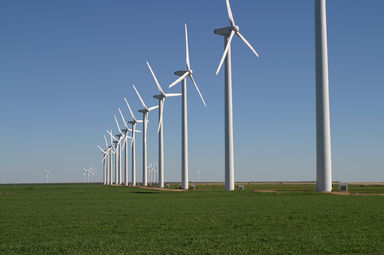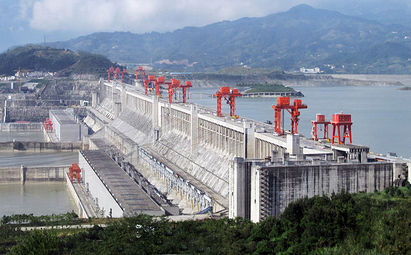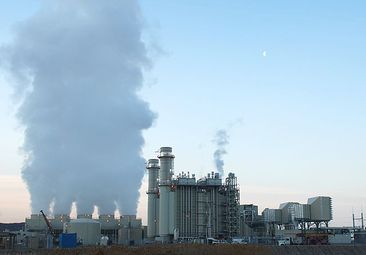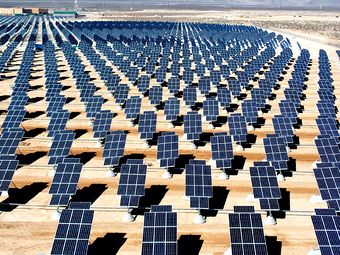Power plant: Difference between revisions
J.williams (talk | contribs) m (1 revision imported) |
2dev>Jmdonev No edit summary |
||
| Line 1: | Line 1: | ||
[[Category:Done | [[Category:Done 2018-12-10]] | ||
<onlyinclude>A '''power plant''' is an industrial facility that [[electrical generation|generates electricity]] from [[primary energy]]. Most power plants use one or more [[generator]]s that convert [[mechanical energy]] into [[electrical energy]] in order to [[power]] the [[electrical grid]] | <onlyinclude>A '''power plant''' is an industrial facility that [[electrical generation|generates electricity]] from [[primary energy]]. Most power plants use one or more [[generator]]s that convert [[mechanical energy]] into [[electrical energy]]<ref name = oxford>A. Atkins and M. Escudier, A dictionary of mechanical engineering. Oxford: Oxford University Press, 2013</ref> in order to supply [[power]] to the [[electrical grid]] for society's [[electricity|electrical]] needs. The exception is solar power plants, which use [[photovoltaic cell]]s (instead of a [[turbine]]) to generate this electricity.</onlyinclude> | ||
<gallery caption="Examples of Power Plants" mode=packed heights=170px> | <gallery caption="Examples of Power Plants" mode=packed heights=170px> | ||
| Line 8: | Line 8: | ||
</gallery> | </gallery> | ||
The type of [[fuel]] or [[flow]] that | The type of [[fuel]] or [[flow]] that provides a power plant its primary [[energy]] varies. The most common ''fuels'' are [[coal]], [[natural gas]], and [[uranium]] ([[nuclear power]]). A substantially used primary energy ''flow'' for electricity generation is [[hydroelectricity]] (water). Other flows that are used to generate electricity include [[wind]], [[solar power|solar]], [[geothermal electricity|geothermal]] and [[tidal power|tidal]]. | ||
Different countries get their electricity from different types of power plants. For example, in Canada, most electricity generation comes from [[hydroelectric facilities|hydroelectric power plants]] which | Different countries get their electricity from different types of power plants. For example, in Canada, most electricity generation comes from [[hydroelectric facilities|hydroelectric power plants]] which accounts for about 60% of the total electricity generated in Canada.<ref>Canadian Electricity Association. (April 4, 2015). ''Canada's Electricity Industry'' [Online]. Available: http://www.electricity.ca/media/Electricity101/Electricity101.pdf</ref> Please see the [[Power plant#World Electricity Generation|data visualization]] below to explore how countries around the world get their electricity. | ||
<gallery mode=packed heights=170px> | <gallery mode=packed heights=170px> | ||
File:hydrodamchina.jpg|[[Hydroelectric facility|Hydroelectric power plant]].<ref>Wikimedia Commons [Online], Available: https://upload.wikimedia.org/wikipedia/commons/a/ab/ThreeGorgesDam-China2009.jpg</ref> | File:hydrodamchina.jpg|[[Hydroelectric facility|Hydroelectric power plant]].<ref>Wikimedia Commons [Online], Available: https://upload.wikimedia.org/wikipedia/commons/a/ab/ThreeGorgesDam-China2009.jpg</ref> | ||
File:natgaspp.jpg|[[Natural gas power plant]].<ref>Wikimedia Commons [Online], Available: https://upload.wikimedia.org/wikipedia/commons/c/cb/Lake_Side_Power_Plant.jpg</ref> | File:natgaspp.jpg|[[Natural gas power plant]].<ref>Wikimedia Commons [Online], Available: https://upload.wikimedia.org/wikipedia/commons/c/cb/Lake_Side_Power_Plant.jpg</ref> | ||
File:Solar farm.jpg|[[Solar panel]] farm.<ref>Wikimedia Commons [Online], Available: https://upload.wikimedia.org/wikipedia/commons/4/45/Giant_photovoltaic_array.jpg | File:Solar farm.jpg|[[Solar panel]] farm.<ref>Wikimedia Commons [Online], Available: https://upload.wikimedia.org/wikipedia/commons/4/45/Giant_photovoltaic_array.jpg</ref> | ||
</gallery> | </gallery> | ||
| Line 22: | Line 22: | ||
===Thermal=== | ===Thermal=== | ||
Most [[thermal power]] plants use | Most [[thermal power]] plants use fuel to heat up water from a reservoir, which generates [[steam]](usually at a high [[pressure]]). The highly pressurized steam then travels through pipes to rotate the fan-like blades of a [[turbine]] (see [[Rankine cycle]] for more info). As the turbine begins to spin, it causes giant [[wire]] coils inside the generator to turn. This creates relative (continuos) motion between a coil of wire and a [[magnet]], which pushes [[electron]]s and starts the flow of electricity.<ref name=ent>Entergy. (April 4, 2015). ''Power Plants'' [Online]. Available: http://www.entergy.com/energy_education/power_plants.aspx</ref> | ||
*'''[[Fossil fuel]]''' power plants [[combustion|burn]] their fuel in order to create the [[thermal energy]] to run their external heat engines. A [[simple cycle gas plant]] does not use steam like the others: it works similar to a jet engine where [[natural gas]] is ignited and burned and the [[heat]] creates pressure that turns the turbine. [[Combined cycle gas plant]]s use both the | *'''[[Fossil fuel]]''' power plants [[combustion|burn]] their fuel in order to create the [[thermal energy]] to run their external heat engines. A [[simple cycle gas plant]] does ''not use steam'' like the others: it works similar to a jet engine where [[natural gas]] is ignited and burned and the [[heat]] creates pressure that turns the turbine. [[Combined cycle gas plant]]s use both the heat and steam as well. Types of fossil fuel plants include [[coal-fired power plant]]s and [[natural gas power plant]]s—accounting for the largest producers of electricity around the world (see [[Power plant#World Electricity Generation|data visualization]] below). | ||
*'''[[Nuclear power plant|Nuclear]]''' power plants use [[fission]] processes to generate electricity. In these plants, uranium [[nuclei]] are split which creates the thermal energy needed to create steam. It then works just like fossil fuel power plants where the steam spins a turbine, generating electricity. The power plants require the use of [[nuclear reactor]]s to carry out these fission processes. Some types of reactors include [[pressurized water reactor]]s, [[CANDU reactor]]s, [[RBMK]] reactors, and [[boiling water reactor]]s. | *'''[[Nuclear power plant|Nuclear]]''' power plants use [[fission]] processes to generate electricity. In these plants, uranium [[nuclei]] are split which creates the thermal energy needed to create steam. It then works just like fossil fuel power plants where the steam spins a turbine, generating electricity. The power plants require the use of [[nuclear reactor]]s to carry out these fission processes. Some types of reactors include [[pressurized water reactor]]s, [[CANDU reactor]]s, [[RBMK]] reactors, and [[boiling water reactor]]s. | ||
| Line 35: | Line 35: | ||
===Renewable=== | ===Renewable=== | ||
[[Renewable energy]] power plants get their energy directly from their respective flows in order to generate electricity. These primary energy sources replenish themselves eventually, but are limited in the amount of energy that is available at any given time or place | [[Renewable energy]] power plants get their energy directly from their respective flows in order to generate electricity. These primary energy sources replenish themselves eventually, but are limited in the amount of energy that is available at any given time or place. Therefore they are often [[intermittent electricity|intermittent]] and [[non-dispatchable source of electricity|non-dispatchable]].<ref name=ent/> | ||
*'''[[Hydroelectric facilities]]''' use energy from falling water in rivers and reservoirs to spin a generator and create electricity. This energy source tends to be more [[dispatchable source of electricity|reliable]] than other renewable resources, especially when the facility runs off of a reservoir.<ref>First Hydro Company, ''Dinorwig Power Station'' [Online], Available: http://www.fhc.co.uk/dinorwig.htm</ref> | *'''[[Hydroelectric facilities]]''' use energy from falling water in rivers and reservoirs to spin a generator and create electricity. This energy source tends to be more [[dispatchable source of electricity|reliable]] (dispatchable) than other renewable resources, especially when the facility runs off of a reservoir.<ref>First Hydro Company, ''Dinorwig Power Station'' [Online], Available: http://www.fhc.co.uk/dinorwig.htm</ref> | ||
*'''[[Wind turbine]]s''' get their energy from wind, which upon contact slows down and transfers [[kinetic energy]] to the turbine. [[Air drag]] causes the turbine to spin, and the maximum efficiency of turbines is given by the [[Betz limit]]. | *'''[[Wind turbine]]s''' get their energy from wind, which upon contact slows down and transfers [[kinetic energy]] to the turbine. [[Air drag]] causes the turbine to spin, and the maximum efficiency of turbines is given by the [[Betz limit]]. | ||
*'''[[Solar panel]]s''' use photovoltaic cells in order to create electricity. The incoming [[photon]]s from the Sun hit [[atom]]s inside the panel's [[semiconductor]]s which causes [[electron]]s to flow. Solar | *'''[[Solar panel]]s''' use photovoltaic cells in order to create electricity. The incoming [[photon]]s from the [[Sun]] hit [[atom]]s inside the panel's [[semiconductor]]s which causes [[electron]]s to flow. Solar energy is intermittent but combined with [[energy storage]] [[technology]] their power can be much more reliable. | ||
==Transportation of electricity== | ==Transportation of electricity== | ||
| Line 52: | Line 52: | ||
<html><iframe class='charts-iframe' id='world-energy'></iframe></html> | <html><iframe class='charts-iframe' id='world-energy'></iframe></html> | ||
==For Further Reading== | |||
*[[Electricity]] | |||
*[[Primary energy]] | |||
*[[Fuel vs flow]] | |||
*[[Thermal power]] | |||
*[[Renewable energy]] | |||
*[[Electricity storage system]] | |||
*Or explore a [[Special:Random|random page]] | |||
==References== | ==References== | ||
{{reflist}} | {{reflist}} | ||
[[Category:Uploaded]] | [[Category:Uploaded]] | ||
Revision as of 06:00, 20 October 2018
A power plant is an industrial facility that generates electricity from primary energy. Most power plants use one or more generators that convert mechanical energy into electrical energy[1] in order to supply power to the electrical grid for society's electrical needs. The exception is solar power plants, which use photovoltaic cells (instead of a turbine) to generate this electricity.
- Examples of Power Plants
Wind power farm.[4]
The type of fuel or flow that provides a power plant its primary energy varies. The most common fuels are coal, natural gas, and uranium (nuclear power). A substantially used primary energy flow for electricity generation is hydroelectricity (water). Other flows that are used to generate electricity include wind, solar, geothermal and tidal.
Different countries get their electricity from different types of power plants. For example, in Canada, most electricity generation comes from hydroelectric power plants which accounts for about 60% of the total electricity generated in Canada.[5] Please see the data visualization below to explore how countries around the world get their electricity.
Solar panel farm.[8]
Types of Power Plants
Thermal
Most thermal power plants use fuel to heat up water from a reservoir, which generates steam(usually at a high pressure). The highly pressurized steam then travels through pipes to rotate the fan-like blades of a turbine (see Rankine cycle for more info). As the turbine begins to spin, it causes giant wire coils inside the generator to turn. This creates relative (continuos) motion between a coil of wire and a magnet, which pushes electrons and starts the flow of electricity.[9]
- Fossil fuel power plants burn their fuel in order to create the thermal energy to run their external heat engines. A simple cycle gas plant does not use steam like the others: it works similar to a jet engine where natural gas is ignited and burned and the heat creates pressure that turns the turbine. Combined cycle gas plants use both the heat and steam as well. Types of fossil fuel plants include coal-fired power plants and natural gas power plants—accounting for the largest producers of electricity around the world (see data visualization below).
- Nuclear power plants use fission processes to generate electricity. In these plants, uranium nuclei are split which creates the thermal energy needed to create steam. It then works just like fossil fuel power plants where the steam spins a turbine, generating electricity. The power plants require the use of nuclear reactors to carry out these fission processes. Some types of reactors include pressurized water reactors, CANDU reactors, RBMK reactors, and boiling water reactors.
- Solar thermal power plants use heat from the sun’s rays to create the steam that is needed to rotate the turbine.

Thermal power plants are all limited by the second law of thermodynamics, which means they cannot transform all of their heat energy into electricity. This limits their efficiencies, which can be read about on the Carnot efficiency and entropy pages.
Renewable
Renewable energy power plants get their energy directly from their respective flows in order to generate electricity. These primary energy sources replenish themselves eventually, but are limited in the amount of energy that is available at any given time or place. Therefore they are often intermittent and non-dispatchable.[9]
- Hydroelectric facilities use energy from falling water in rivers and reservoirs to spin a generator and create electricity. This energy source tends to be more reliable (dispatchable) than other renewable resources, especially when the facility runs off of a reservoir.[11]
- Wind turbines get their energy from wind, which upon contact slows down and transfers kinetic energy to the turbine. Air drag causes the turbine to spin, and the maximum efficiency of turbines is given by the Betz limit.
- Solar panels use photovoltaic cells in order to create electricity. The incoming photons from the Sun hit atoms inside the panel's semiconductors which causes electrons to flow. Solar energy is intermittent but combined with energy storage technology their power can be much more reliable.
Transportation of electricity
Once electricity is generated, transformers "step-up" the electric power to a higher voltage in order to travel long distances with minimal energy loss. It then travels through "pylons" along overhead power cables to its destination, where transformers subsequently "step-down" the electric power to safe voltages for houses and utilities. For a more complete story please see electrical transmission.
World Electricity Generation
The map below shows which primary energy source different countries get the energy to generate their electricity from. Click on the region to zoom into a group of countries, then click on the country to see where its electricity comes from.
For Further Reading
- Electricity
- Primary energy
- Fuel vs flow
- Thermal power
- Renewable energy
- Electricity storage system
- Or explore a random page
References
- ↑ A. Atkins and M. Escudier, A dictionary of mechanical engineering. Oxford: Oxford University Press, 2013
- ↑ Wikimedia Commons [Online], Available: http://upload.wikimedia.org/wikipedia/commons/b/bb/Gundremmingen_Nuclear_Power_Plant.jpg
- ↑ Wikimedia Commons [Online], Available: https://upload.wikimedia.org/wikipedia/commons/4/4d/Fermi_NPP.jpg
- ↑ Wikimedia Commons [Online], Available: https://upload.wikimedia.org/wikipedia/commons/8/8b/GreenMountainWindFarm_Fluvanna_2004.jpg
- ↑ Canadian Electricity Association. (April 4, 2015). Canada's Electricity Industry [Online]. Available: http://www.electricity.ca/media/Electricity101/Electricity101.pdf
- ↑ Wikimedia Commons [Online], Available: https://upload.wikimedia.org/wikipedia/commons/a/ab/ThreeGorgesDam-China2009.jpg
- ↑ Wikimedia Commons [Online], Available: https://upload.wikimedia.org/wikipedia/commons/c/cb/Lake_Side_Power_Plant.jpg
- ↑ Wikimedia Commons [Online], Available: https://upload.wikimedia.org/wikipedia/commons/4/45/Giant_photovoltaic_array.jpg
- ↑ 9.0 9.1 Entergy. (April 4, 2015). Power Plants [Online]. Available: http://www.entergy.com/energy_education/power_plants.aspx
- ↑ http://www.nrc.gov/reading-rm/basic-ref/students/animated-bwr.html
- ↑ First Hydro Company, Dinorwig Power Station [Online], Available: http://www.fhc.co.uk/dinorwig.htm







